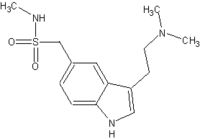A 34 year old man with a history of migraine presented with palpitations after taking sumatriptan by nasal spray for a severe headache. Examination was unremarkable apart from atrial fibrillation, with a ventricular rate of 130 beats/min. He recalled having had a fast irregular pulse after taking sumatriptan previously, and this was confirmed from his case notes. He reverted to sinus rhythm spontaneously within 12 hours of admission. Thyroid function tests and a transthoracic echocardiogram gave normal results. Exercise stress testing showed no abnormalities.
Sumatriptan is a 5-hydroxytryptanine agonist active at 5-hyroxytryptanine 1B and 1D receptors. Chest tightness and pain are reported in up to 15% of patients and are presumed to be due to vasoconstriction of the coronary arteries.[1] At therapeutic plasma concentrations, sumatriptan does not reduce myocardial perfusion in healthy migraineurs.[2] Myocardial infarction has, however, been reported as a consequence of sumatriptan treatment for migraine and its use is contraindicated in patients with ischaemic heart disease.[1]
Sumatriptan is the drug most frequently reported to cause chest pain.[3] Atrial fibrillation associated with sumatriptan is uncommon. The Committee on Safety of Medicines has received six reports of atrial fibrillation associated with sumatriptan, which accords with data from the manufacturer. Naratriptan has been associated with one episode of atrial fibrillation. The Committee on Safety of Medicines has received no reports of arrhythmias with rizatriptan, but it has been associated with tachycardia and chest pain (data from manufacturers).
In this patient's case there was evidence of rechallenge, implicating sumatriptan as the cause of the atrial fibrillation, irregular tachycardia having been previously documented after sumatriptan use. The mechanism causing atrial fibrillation is uncertain. In this patient underlying coronary insufficiency seems unlikely. Sumatriptan has been shown to be without inherent tachycardic effect in in vivo preparations of denervated cat heart.[4] Therefore, we suggest that myocardial ischaemia secondary to coronary vasospasm could be a trigger for atrial fibrillation.
Competing interests: None declared.
[1] VanDenBrink AM, Reekers M, Bax WA, Ferrari MD, Saxena PR. Coronary side-effect potential of current and prospective antimigraine drugs. Circulation 1998;95:25-30.
[2] Lewis PJ, Barrington SF, Marsden PK, Maisey MN, Lewis LD. A study of the effects of sumatriptan on myocardial perfusion in healthy female migraineurs using [sup.13][NH.sub.3] positron emission tomography. Neurology 1997;48:1542-50.
[3] Ottervanger JP, Wilson JHP, Stricker BHC. Drug-induced myocardial infarction. Reports to a national centre and review of the literature. Eur J Clin Pharmacol 1997;53:105-10.
[4] Villalon CM, Heiligers JPC, Centurion D, De Vries P, Saxena PR. Characterization of putative 5-HT7 receptors mediating tachycardia in the cat. Br J Pharmacol 1997;121:1187-9.
D R Morgan, M Trimble, G E McVeigh, General Medicine Department, Belfast City Hospital, Belfast BT9 7AB
COPYRIGHT 2000 British Medical Association
COPYRIGHT 2000 Gale Group



